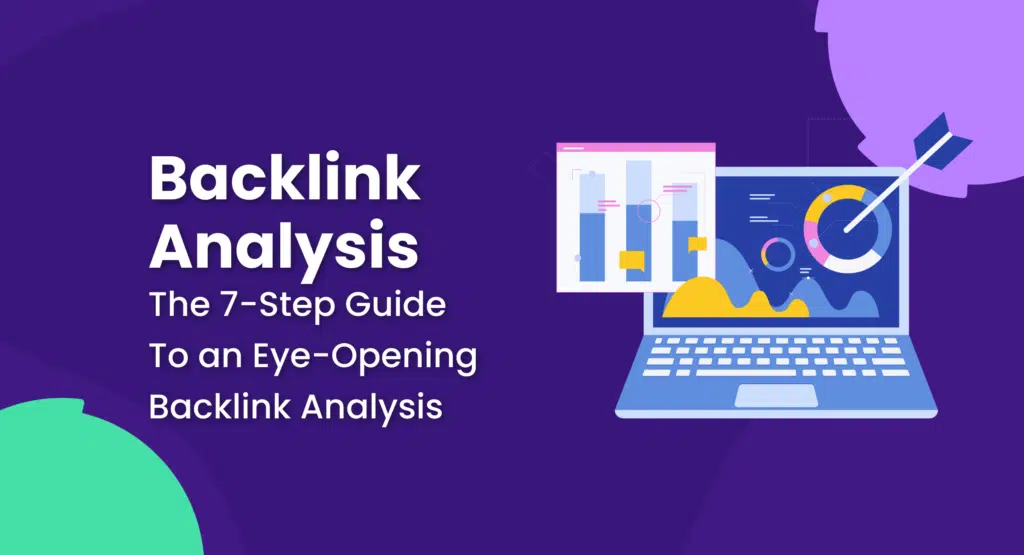
Backlinks remain one of the most powerful drivers of organic traffic and domain authority. For SEO professionals, regular backlink analysis isn’t just recommended – it’s essential for staying competitive.
While quantity matters, the real goal is building a robust, diverse link portfolio. Before revamping your link-building strategy, you need a clear picture of where you stand through systematic backlink analysis.
This blog post explores both fundamental and advanced backlink analysis techniques, specifically tailored for SEO professionals aiming to enhance their organic search performance.
What Is Backlink Analysis?
Backlink analysis is the identification and examination of inbound links to your website. It involves assessing the quality and relevance of those links. You can then understand their influence on search engine rankings and create strategies to improve your website’s SEO performance. Backlink analysis is an essential practice for any effective SEO campaign.
Your analysis can be highly flexible, and you’ll need to adapt it to the context and goals of your current project.
One of the primary motivations for conducting a backlink analysis is to uncover new link-building opportunities. By examining your site’s backlink profile, you can identify the sources of your most valuable links.
This data can help you create top-quality content and build more incoming links. Backlink analysis can also uncover possibilities for potential partnerships or collaborations that you may not have noticed otherwise.
With a backlink analysis, you’ll know exactly how you stack up against your competition. You can compare your backlink profile with your competitors to reveal strengths to capitalize on and weaknesses to address. This competitive intelligence process gives you a sneak peek into the link-building strategies of other successful sites in your niche.
You can also find out when reputable sites link to you — a nice, reassuring nod to your website’s growth and relevance in the online landscape.
The Best Ways to Find Your Website’s Backlinks
There’s no way around it: To conduct a comprehensive backlink analysis, you’ll need at least one external tool specifically designed to crawl the web and document backlinks.
Google Search Console (GSC) does offer some backlink information, but it’s not reliable or thorough enough to give you the complete picture of your backlink profile.
My top pick for backlink analysis is Semrush. It gives you backlinks, referring domains, and authority scores. It also helps you keep track of the balance between Follow and Nofollow links.
Ahrefs, Serpstat, and Moz are other solid contenders.
Each tool offers unique features, and you’ll need to pick the one that meets your specific needs, budget, and personal preferences. Remember that your goal is not just to discover your backlinks, but to understand their influence on your site’s performance and use this information to shape your SEO strategy.
How to Perform a Backlink Analysis
Ready to conduct your own backlink analysis? Here are the seven steps you’ll need to follow.
Step #1: Identify All Your Backlinks
Start your analysis by using Semrush or another backlink audit tool to examine all the links that point to your site.
Let’s take a look at a site Nick explored in his post on competitor keywords, as an example.
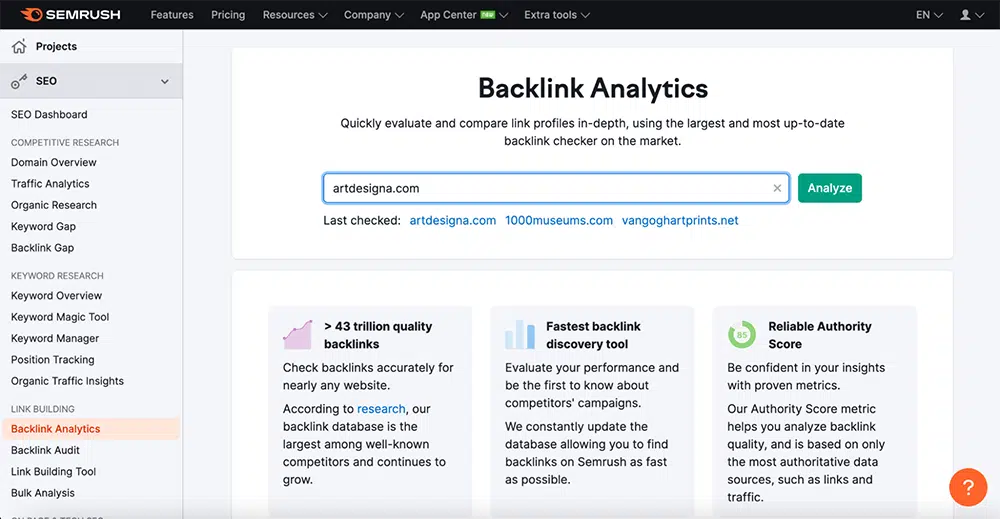
You’ll gather comprehensive data about who’s linking to your site, the content they’re linking from, and how they’re linking to you (anchor text, Follow/Nofollow status, etc.).
These inbound links come from diverse sources, including blog posts, forums, directories, and other websites that find your content valuable.
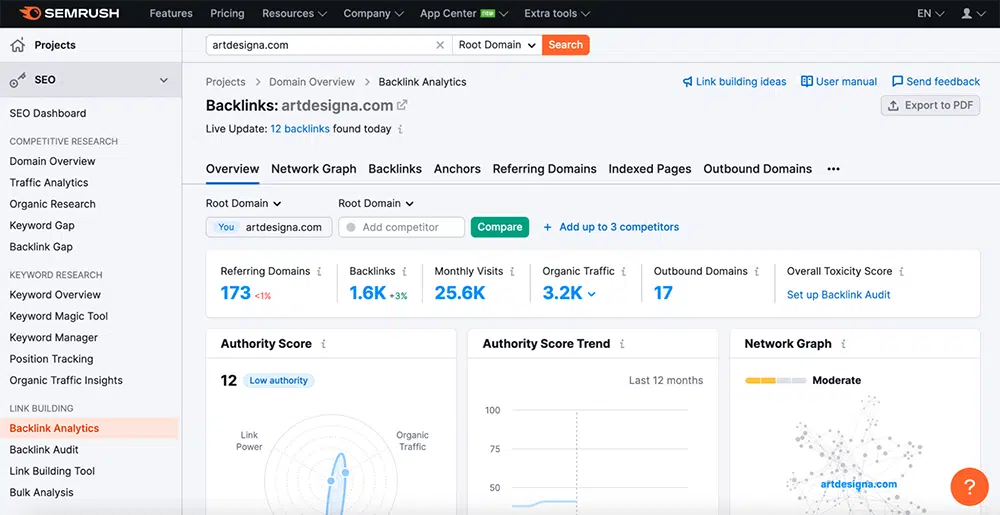
Creating this initial inventory of backlinks is crucial because it sets the groundwork for your analysis.
It’s similar to piecing together a jigsaw puzzle. Every backlink is part of a larger picture that reveals your site’s connectivity on the web. This initial list of backlinks is the starting point that guides the rest of your analysis and SEO reporting.
Step #2: Look at the Follow/Nofollow Ratio
Once you’ve compiled your list of backlinks, examine the ratio of Follow to Nofollow links.
Dofollow links pass on link equity and can boost your website’s SEO. Nofollow links don’t convey link juice but still contribute to a solid, diverse backlink profile. Nofollows indicate to search engines that your backlink profile isn’t artificially manipulated, which is good because manipulating your backlink profile with black hat SEO techniques could trigger penalties.
While there’s no universally applicable rule, aim for a ratio of around 60% Follow to 40% Nofollow links. This mix helps you maintain an organic and balanced link profile, which search engines favor.
In the example below, you’ll see a ratio of 74% Follow to 26% Nofollow.
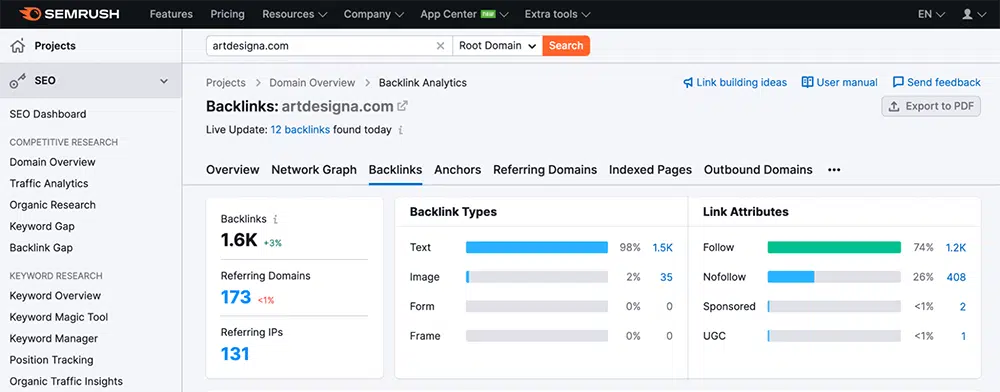
The optimal ratio may differ based on factors like your industry, the age of your website, etc. The key is to ensure your link profile doesn’t appear manipulated and maintains a healthy mix of Follow and Nofollow links.
Step #3: Examine Your Total Links to Linking Domains Ratio
Next, review the ratio of total backlinks to linking domains. This will give you insight into the breadth and diversity of your link profile — key factors that search engines consider when evaluating your site’s authority.
Having a high number of linking domains is generally a positive sign. It indicates that your content is valuable — you have relevant backlinks from a diverse range of sources.
But if your backlinks come predominantly from a limited set of domains, it may raise red flags. That situation could suggest that your link profile lacks diversity or has been artificially manipulated. Both of which could lead to penalties from search engines.
Remember, your off-page SEO goal isn’t to stockpile backlinks. It’s to acquire links from a wide variety of domains. Your backlink profile is about quality as much as it’s about quantity.
Strive for a diverse mix of backlinks from different domains, and the search engines will know you’ve got an organically grown (and reputable) profile.
Search engines strive to provide the most valuable content to users, and a healthy total links to linking domains ratio, signals that your content is widely recognized as beneficial across sources.
Step #4: Analyze the Domain Ratings of Your Backlinks
The fourth step in your backlink analysis process is evaluating the Authority Score (AS) of your backlinks. AS quantifies the authority and credibility of a website, and higher values indicate stronger authority. Having backlinks from high-AS sites can improve your website’s authority and rankings, but it’s not the only factor to consider.
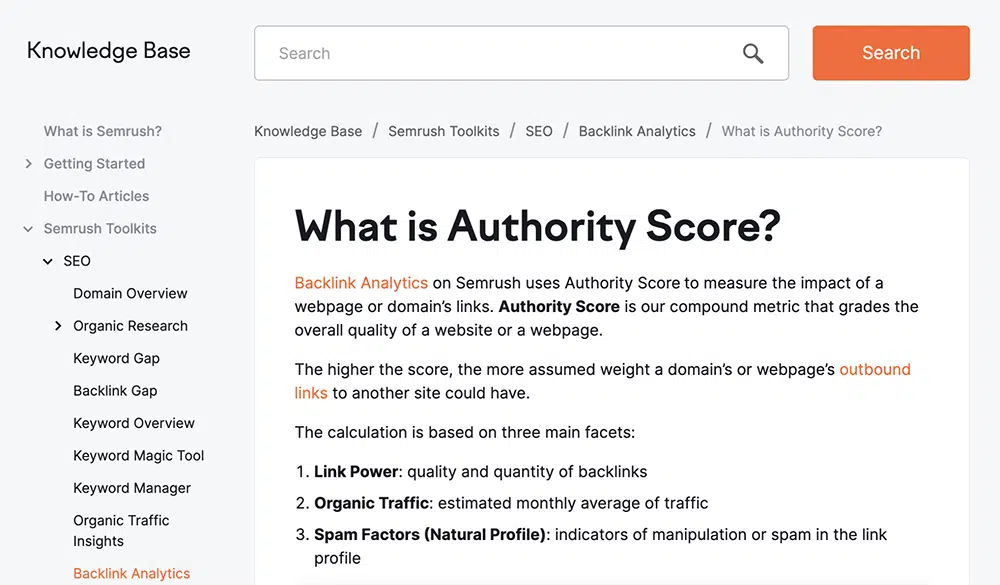
While you want high-AS sites to link to you, the relevance of the linking domain to your content is even more critical than a site’s specific AS. A backlink from a high-AS but unrelated site might not contribute as much to your SEO efforts as a link from a moderately-rated but highly relevant site.
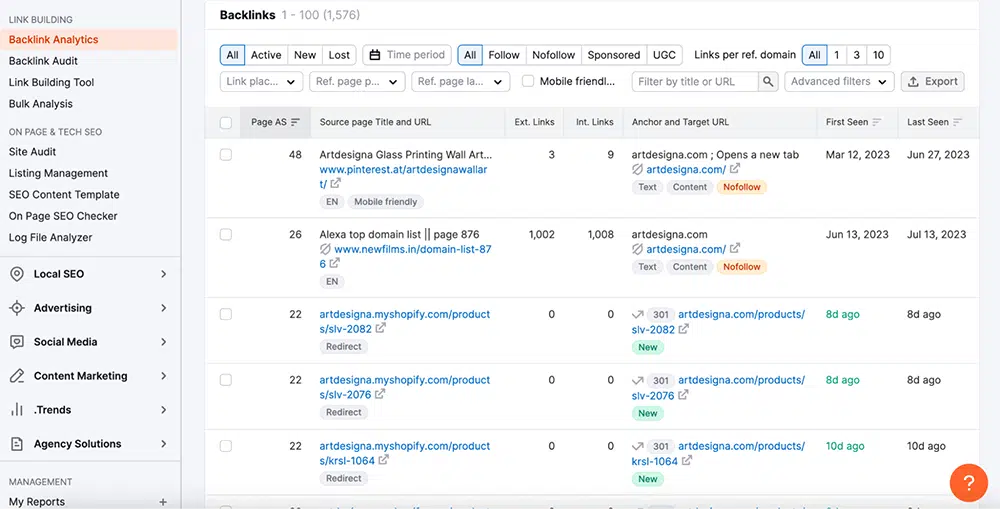
Search engines value relevance and context. They aim to provide users with the most pertinent content, which means they place considerable importance on content alignment between linked sites.
Strive for backlinks from domains that are both authoritative and relevant to your content to get the biggest bang for your buck in your SEO efforts.
Step #5: Check Link Relevance
Speaking of relevancy, let’s look at how to verify whether your backlink sources align with the topic and purpose of your site.
Again, a backlink from a site within the same or a similar industry, or a site that covers related topics, is generally more valuable than a link from an entirely unrelated source.
Go through your backlinks and examine the source of each link.
Ask yourself:
- Does the content surrounding the link complement or add value to my content?
- Would a visitor from the linking site find my content beneficial and relevant?
- Does this website operate in the same industry or sector as my site?
- Is the link from a site that my target audience would typically visit?
- Is this a source my audience would find credible and helpful?
- Does this website’s content align with mine?
By ensuring your backlinks come from relevant sources, you can increase the quality of your link profile, boost your site’s credibility, and improve your ranking.
Step #6: Manually Group Links by Type
For the next step in your backlink analysis, you’ll group your backlinks by category.
Common types include:
- Product reviews
- Web directories
- News articles
- Forum posts
- Guest posts
- Blogs
Sorting your backlinks gives insight into what kinds of content or platforms drive the most links to your site. Are they from guest posts you’ve written? Directories where your site is listed? Blogs that have organically referenced your content?
The answers to these questions will shape your content creation and link-building strategies.
For example, if you notice that guest posts on certain types of blogs bring in a significant number of quality backlinks, you might want to focus on forming more of those kinds of partnerships.
Or if you see that most of your backlinks come from web directories, you may want to diversify your backlink strategy to include other link-building activities for a more balanced backlink profile.
Keep in mind that while it’s great to capitalize on what works, search engines also value diversity in your backlinks. Aim to gather links from a variety of sources so your profile appears more balanced and not manipulated by a backlink network.
Step #7: Analyze Anchor Text
The next step in your backlink profile analysis process is to identify the anchor text associated with your backlinks. Anchor text — the clickable text readers see in a hyperlink — plays a crucial role in providing context to users and search engines about the linked content.
When examining your backlinks, check the words or phrases used in the anchor text. Ideally, linking sites would use your target keywords as anchor text, providing a direct relevance signal to search engines and potentially improving your site’s ranking for those keywords.
In reality, this doesn’t happen very often, as you can see below.
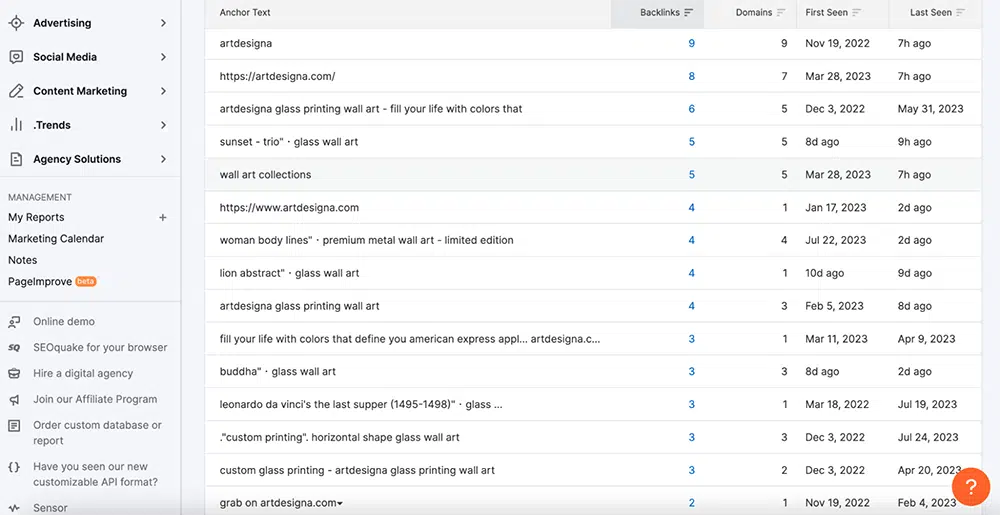
In many cases, the anchor text for most of your backlinks will be your brand name or your website’s URL. While these types of anchor texts don’t provide the same level of keyword relevancy, they can still contribute positively to your brand awareness and online presence.
They signal to search engines that your brand is being discussed and referenced across the web, which can increase your authority and credibility.
Diversity is important in anchor text, too. Just as with your backlinks, having a variety of anchor texts can make your link profile look more natural and less like it’s been artificially manipulated. A mix of branded, keyword-rich, and generic anchor texts can contribute to a healthy link profile.
Done with Your Analysis? Here’s How to Polish Your Backlink Profile
Once you’ve conducted a thorough backlink analysis, the final step is refining and polishing your backlink profile. You’ll take the data you’ve uncovered and turn it into actionable steps.
Depending on the findings of your analysis, your action plan might include:
- Reaching out to website administrators
- Seeking new backlink opportunities
- Addressing discrepancies
- Submitting a Disavow file
If your analysis uncovers significant discrepancies (like unnatural anchor text distribution or an excess of Follow or Nofollow links), I recommend taking immediate action.
Contact site owners or web administrators to help rectify the issues you spot. They can update anchor texts or adjust the Follow status of certain links.
If you discover a number of suspicious or low-quality backlinks pointing to your site, you might need to learn how to disavow backlinks. This involves uploading a Disavow file to Google to inform the search engine that it should disregard these backlinks when assessing your website, which can protect you from potential penalties.
During this stage of your analysis, always look for new opportunities to grow and diversify your backlink profile. This might involve submitting your site to reputable web directories or reaching out to related blogs for guest posting opportunities.
Stay Competitive by Adding a Backlink Analysis to Your SEO Routine
Backlink analysis and refinement are not one-time tasks. You’ll need to regularly analyze your backlink profile to ensure it stays robust and relevant, so you can continue to climb the ranks in the SERPs.
Through backlink analysis, you’ll gain valuable insights into your website’s profile and understand its strengths and weaknesses, so you can spot opportunities to improve it.
With this approach, you’re well on your way to improving your website’s visibility, authority, and rankings.
Looking for an easy way to start your backlink analysis? Try out Semrush’s for yourself!
Semrush
- Semrush – Best overall SEO functionality
- Google Search Console – Best free (partial) data from Google
- Advanced Web Ranking – Best for reporting
- SERPWatcher by Mangools – Best for bloggers and small teams
- Ahrefs – Best for keyword analysis
- SEO PowerSuite – Best affordable option
- SEO Monitor – Best for forecasting
- Local Viking – Best for local SEO map tracking
- Nozzle – Best for data visualization
- ProRankTracker – Best for agencies and SEO professionals